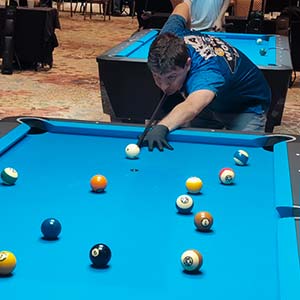
by Dr. William Sen
When you see the Predator brand at almost every major pool billiard tournament, it’s easy to wonder: is it all just marketing? Predator isn’t just a minor sponsor; their banners are a common sight at events worldwide, and they sponsor some of the top names in the sport. However, behind the flashy promotions and high-profile endorsements, questions arise about the actual value of Predator cue sticks. Are you paying for the quality of the product, or primarily for the brand name and its prestige?
In this article, we will explore the reality behind Predator’s reputation, customer service, product quality, and the real cost of owning a Predator cue stick in today’s competitive market in 2025.
Marketing vs. Material
Today you will see the Predator brand at almost every major pool billiard tournament, from the Mosconi Cup to the World Championships.
Predator isn’t just a minor sponsor; their banners are a common sight at events across the globe, including those organized by WPA including AAPA, ACBS, BCA, CPB, EPBF, and OPBA. Moreover, they sponsor some of the top names in the sport, like Joshua Filler, Jasmin Ouschan, Kelly Fisher, and Eklent Kaci.
It appears that a significant portion of Predator’s budget goes into marketing and sponsorships. So, when you buy a Predator cue stick, a part of what you’re paying is funneling directly into these flashy promotions and high-profile endorsements.
This raises an interesting point for consumers: When you purchase from Predator, are might be primarily funding the ongoing spectacle of the sport rather than investing in the tangible quality of your own equipment.
It’s basically owning a high-end fashion brand. The material itself is just like any other good quality material, but what you pay for is in my opinion the name. Owning a Predator cue stick is like carrying and wearing Louis Vuitton, Gucci, Prada, Hermès, Lululemon Athletica, or Burberry.
Predator has evolved into a fashion statement within the billiards community. It’s about projecting a “cool” image when you show up at your local league play or tournament with Predator products.
This concept isn’t unique to fashion or billiards; it’s prevalent in many industries where brand identity and perception can dictate a significant portion of the product’s price.
Is It “Made in China”?
Despite its association with American cue sports, Predator Group today might not be homegrown as you might think. Registered officially as Clawson Custom Cues, Inc., “Predator Group” is simply a DBA (Doing Business As) the company uses. But let’s try to answer this question: Where are Predator cues actually made?
Although Predator maintains its headquarters Florida, it’s being rumored widely that all their cue sticks are now manufactured in China — a detail not publicly disclosed by the company and might be a well kept secret.
Obfuscation is part of a broader strategy used by many brands to avoid scrutiny over quality and the appeal of American manufacturing. Why does this matter? Well, it comes down to value perception, transparency and comparison. If customers knew they were buying a product made in China, they might hesitate to pay a premium price that is often higher than other China-made cue sticks. By letting consumers assume the products are American-made, companies can command higher prices under the guise of domestic production. It means, if the assumption in general is that you’re dealing with an American-Made product, this could sway your decision unjustly from buying other products from competitors.
Karim Belhaj: CEO of Predator
Karim Belhaj, the head of Predator displays a diverse international background. He is originally from Puerto Rico, where he currently resides, grew up in France, and he has also studied in Hong Kong, China. Allan McCarty, one of the original U.S.-founders of Predator, parted ways with the company some time ago, during which his shares were acquired by Karim Belhaj.
Predator’s promotional videos insinuating that their cue sticks are made in the U.S. but during my research I couldn’t find one singe statement that they actually are However, these videos focus on the final stages of assembly, showing machines measuring and installing joints and tips on the shafts. What we do not see on thise videos are, how and where the carbon tapered shafts themselves are manufactured. This selective presentation could be seen as a clever marketing strategy, giving the illusion of the production’s location being the U.S. while it’s actually not.
Has Predator Invtented Carbon Fiver Cue Sticks?
Yes: Predator was the first company to introduce Carbon Fiver Cue Sticks. Paul Costain, a legendary figure within the scene, significantly contributed to the engineering of Predator’s carbon fiber shaft. Though he retired in 2018, his legacy endures, and he continues to appear in Predator’s promotional videos.
Despite their past innovations, Predator has pivoted from pioneering research and development towards maximizing sales in a highly competitive market. Competitors have now caught up and are adopting and refining the carbon fiber technology to produce high-quality alternatives. However, as in 2025 Predator’s strategy appears to focus on branding and look rather than on further innovation and quality.
Even Predator’s once-praised Uni-Loc technology has faced significant criticism, with pool players frequently complaining about cue sticks becoming loose during gameplay. This issue highlights Predator’s overall emphasis on design. This focus actually was one of the disagreements between the original founder, Allan McCarty, and the current owner, Karim Belhaj. Their differing visions for the company ultimately led to McCarty selling his shares to Belhaj and leaving the company long time ago.
The list of competitors introducing new carbon fiber cue sticks continues to grow, featuring names like Cuetec, McDermott, Lucasi, Meucci, Becue, and newcomers like Bull. Brands such as RHINO are also making an impact by offering high-quality shafts at competitive prices, challenging well-established brands with their value proposition.
One significant challenge for formerly innovative companies like Predator is that their extensively researched and developed technologies can be replicated by competitors. By dissecting a carbon fiber shaft and reverse-engineering it, competitors can uncover the technology used, allowing them to recreate similar shafts with minor modifications to Predator’s unique patterns to sidestep copyright and patent issues. This enables them to build upon Predator’s groundwork, fostering their own distinctive designs and innovations.
The rapid adoption of what was once U.S.-led technology can easily shift to manufacturing hubs like China. Once production is outsourced, local manufacturers gain insight into the technology, enabling Chinese factories to not only produce comparable technology for various brands but also to market carbon fiber shafts under their own brands. Today, numerous carbon fiber manufacturers are listed on platforms like Ali Baba, where a simple search for “Carbon Fiber Cue Shafts” reveals a range of products priced from approximately $5 to $50 each.
While these may not match the high-end quality some pool players seek, there are competitor brands that offer comparable cue sticks at significantly lower prices.
Each cue stick plays differently, though. Although it’s impossible to perfectly replicate another company’s technology, variations always exist. Therefore, Predator’s carbon fiber cue shafts retain their unique characteristics, as do those of other brands.
However, I can see that newcomers to the market are setting themselves apart by offering superior customer support compared to Predator. As a long-standing market leader, Predator appears to have developed perhaps even arrogance about its position. In contrast, emerging competitors are motivated to distinguish themselves by providing enhanced support and assurances to attract customers away from the established giant. While Predator seems to be resting on its laurels, relying heavily on its well-established brand image, it appears their current focus is primarily on maximizing sales, leveraging their prestige to squeeze the most out of their market share. This strategy may prioritize short-term gains over sustained customer loyalty and support.
Talking about customer service: It has gained a reputation among players as the worst in the industry compared to other brands. Let’s take a closer look:
Predator Cue Sticks Customer Service
When you invest in a high-quality cue stick from a brand like Predator, you expect both the product and the service to reflect that quality. Unfortunately, more and more customers are finding that Predator’s after-sales service leaves much to be desired, particularly when it comes to warranty claims.
If your Predator cue stick develops a fault, the company requires you to pay for shipping it back to their facility in Florida. This can cost up to $100 depending on where you live — a significant expense, especially after already paying a premium for the product itself.
This policy has come under scrutiny because many state laws stipulate that consumers shouldn’t have to pay for shipping on defective products. However, Predator’s stance effectively shifts this burden onto the customer, a move that seems to count on customers not taking legal action over such fees.
This approach has sparked discussions about Predator’s customer service philosophy and whether it aligns with the expectations set by their high-end pricing
My personal experience with Predator Cue Sticks’ customer support was also less than satisfactory. When I encountered problems with my Predator cue sticks, I reached out to their support team for assistance.
The interaction turned out to be impersonal and frustrating, dominated by generic responses that seem to be copy-pasted. This approach makes it difficult to get specific questions answered. Replies to my specific queries was met with the same exact frustrating directive to just check their website. This was particularly disheartening after investing nearly $1000 in a BK Rush just less than two months ago.
When I called their customer hotline, the response was apathetic at best. The representative offered only brief, unhelpful replies, giving the impression of someone who had neither the authority to resolve issues nor the motivation to assist. It felt as though they were more eager to end their shift than to address concerns. This level of service reminded me of the inefficiency typically associated with a call to the local DMV.
But as I asked around, it seems that this wasn’t always the case with Predator.
I own three Predator cue sticks, and two of them have failed within just a few months of purchase. My Revo started making strange noises, and after shelling out about $100 to send it back, they did replace it — but at my expense. after just two months of my purchase, my BK Rush broke down. Again, Predator’s support insisted I pay for the shipping costs.
This isn’t just about one or two faulty sticks; it’s about a pattern. Roughly 67% of the Predator sticks I’ve bought have had issues soon after purchase. And I’m not alone in this. Despite the sleek marketing. Predator cues often fall short of the high quality you’d expect — they can be faulty and they do break often.
Conclusion
Predator might no longer hold the title as the only maker of high-quality cue sticks, but their name still carries a lot of weight even among the most trusted experts.
But for competitive pool players looking for quality and value, there are now many other brands that offer great cue sticks at more competitive prices. However, if you care a lot about brand names, Predator might still be your top pick in my opinion. People who choose Predator often go all out, sporting not just the cue sticks but also Predator branded gloves, hats, and T-shirts, showing just how strong the Predator brand remains. While they may not lead in quality or customer support anymore, their image is still top-tier in 2025. Remember, that image also comes with a much higher price tag.





